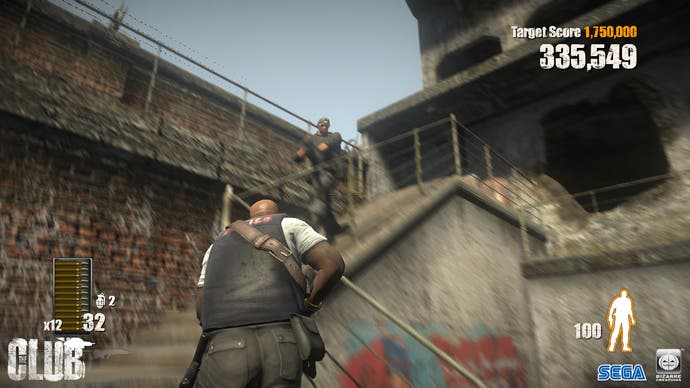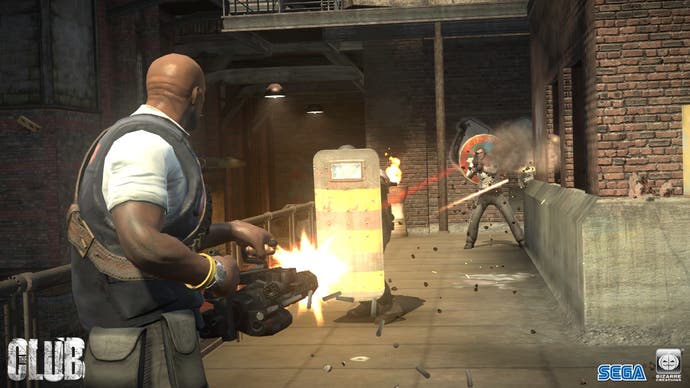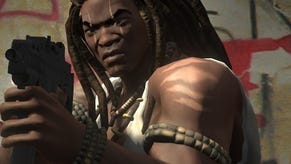The Club
Better than the Ploughman's.
Shooters are big, serious business these days, but The Club is having none of it - you pick from a range of pre-rolled hard-men caricatures with varying speed, strength and stamina statistics and then gun your way at pace through a series of grimy environments racking up kills as quickly as possible to build up combos.
It's from the makers of Project Gotham Racing. PGR wasn't just a brilliant driving game, it was a brilliant high-scores game, where half the fun came from stringing together absurd combinations of power-slides and overtaking manoeuvres and showing off at high speed in a car. The Club does the same trick of leaning into its source material thematically and mechanically but dancing away from it in design.
The result is a shooter that turns tired genre conventions around with a bullet to the shoulder. You're not just clearing levels to get to the next cut-scene, but you yearn for the next identikit enemy to appear, or for a turret gun to control, because these things keep the combo alive. Self-preservation is a secondary consideration; this is all about timing. An ever-present meter in the top-right ticks down from every kill-shot, forcing you to barrel forward for the next one. If you see an enemy, and you have time, you just keep on running toward them, only capping them when the meter's almost empty, doing a forward-roll beforehand to increase your score takeaway.

So the speed and the sense of linking moves together hangs over from PGR, but instead of learning corners, you learn enemy positions. If you fail to tag someone new in time, or to nail a hidden Skullshot icon in that window, then your combo starts to "bleed", reducing your multiplier, and you need to keep that multiplier up because you're not fighting your way to the end, you're fighting to get a better score than the other players on the leaderboard. When playing alone, these are AI players whose scores are presented to you before each round.
Environments, of which there are eight, are split into various tasks each with their own route. Sprints are about simply getting to the exit with the highest score possible, giving you licence to take your time and nail everyone in a sequence that fits the combo meter tempo (see what happens when you practice hard enough over on Eurogamer TV). Time Attacks are laps of each level route scattered with Skullshot time-boosts, clock icons that add to your time limit and a few seconds more for every kill, and Run the Gauntlet is about reaching the exit before the clock runs down. Siege and Survivor levels are the most surprisingly good: the goal is to survive without straying from an area marked out by chalk lines and traffic cones as enemies descend on you from every available angle and zip-line. It's frantic yet subtle, utterly absorbing, and the best fodder for combos, which is the key to everything.

Mechanically, it's a third-person shooter with decent analogue movement and targeting, aiming assists, and a down-the-barrel ironsights L-trigger that helps you to nail distant foes and Skullshots. The smoothness of turning and the fluidity of the visuals combine with an assurance typically unattainable for developers turning out their first shooter, and while there's an occasionally frustrating sluggishness to your movement (although sprinting is fast and unlike, say, Gears, pretty responsive), that frustration is more to do with your eagerness to find the next target than anything bad about the game.
Even so, The Club is likely to prove divisive. Everything it does well flows from a run-and-gun mentality almost alien to modern shooter fans brought up on measured, tactical combat in Halo or Call of Duty. There's no jumping, and you can't climb over a lot of low walls. There's no cover mechanic, which is a bold decision presumably taken because Bizarre wants to keep you on the move, and off-set by an intuitive sense of how much damage you can take: a lot, but not so much that you can afford to ignore health packs, whose consumption becomes increasingly tactical as you fight your way to the end of the single-player campaign.










